Table of Contents
How To Plant Every Variety of Sedum
There are three main types of Sedum plants. Regardless of how long they last or their appearance, all three varieties store moisture in their leaves. If you’ve ever seen skin repair lotion with Sedum listed as an ingredient, this is why.
Sedum is part of the Crassulaceae species. These plants are characterized by succulent leaves which are thick and feel fleshy to the touch. The enlarged part of the leaf is where water is stored. I like to think of these plants as pregnant mirages. They are beautiful, usually survive in the desert, and remain heavy with water.
The three main types of Sedum include mat-forming, creepers, and tall flowers. Several varieties fall within each type.
Growing A Butterfly Garden With Sedum
Mat forming sedum is also known as Stonecrop and can be used for meditative gardening. These are low-maintenance plants that come in several different shapes and colors that match well together. If you live in a hot area such as Arizona or Alabama, mat-forming plants can withstand both summer and winter temperatures.
These are low-growing Sedums that are particularly helpful for rock gardens and borders. I used the Pink Mongolian Stonecrop for my outdoor stone garden because it blooms in the late summer and attracts the butterflies.
According to the Missouri Botanical Gardens, multiple nectar sources are needed to sustain a butterfly garden. Colorful plants will help attract these insects and are ideal when looking at types of mat-forming sedum.
Luckily mat-forming Sedum is one of the easiest succulents to grow. Sun is the biggest requirement. If you live in an open area with few trees, Sedum will grow relatively quickly depending on the soil.
Well-draining soil is imperative for a ground cover. If the soil does not adequately drain after a rainstorm, this can cause rot and mold. An abundance of nutrients is surprisingly frowned upon when planting this kind of crop. Even if the plants do survive with too many nutrients, they will not thrive under these conditions.
It’s important to space out each succulent. They are used for ground cover because of their ability to expand in a short amount of time. Weekly instead of daily watering will help manage their growth.
How To Grow Draping Borders With Sedum
Creeping sedum is often used to soften the edges of borders. This is because they can cling to almost any structure while providing multiple clusters of tiny flowers. I used Sedum spurium on my roof because of the color change. During winter, the leaves turn red giving a dreary day pop of color.
When used on stone walls it can give the impression of a secret garden. Even though it may look fragile, this type of Sedum is incredibly hardy. Creeping Sedum is drought-resistant and long-lasting.
Like other forms of Sedum, you’ll want to space each succulent approximately 18 inches apart. The soil pH is best found between 6.7 and 7.5. Watering every two weeks will ensure the plant does not become oversaturated on a routine basis. The soil should only feel moist after watering.
All-purpose fertilizer works well for both walls and rooftops. Typically a 5-5-5 formula is used to avoid too much nitrogen. If organic fertilizer is purchased, the nutrients may be released at a slower pace.
Flowers that fade will need to be cut with a string trimmer. This keeps the wall or border looking neat and organized. If you prefer the jungle look, however, cutting back can be done every month. Deadheading is not necessary for these plants.
How To Plant Tall Garden Sedums
Tall sedums add depth to any garden. Since this is a perennial, the planting process truly pays off each spring. Tall Sedums come in colors such as burgundy, pink, white, and yellow making them easy to blend in with an existing garden.
Like creeping Sedums, the late summer is its time to shine. A variety titled “Autumn Joy” is specifically planted to hold beauty far into the fall. Typically these flowers are green and provide a quiet softness to the end of hot weather.
After the last frost, Sedums can be planted in the late spring. Since these Sedums are considered “clumping flowers” they will need garden stakes to hold them upright. Heavy twine can be wrapped around the plants before they flower or a metal wire can keep them sturdy.
Low-fertility soil will keep nitrogen levels low. If there is too much nitrogen in the soil then plants are more likely to flower later or not at all. An inch of compost will keep them strong throughout the year.
Since the soil needs to be able to adequately drain, a light mulching is recommended. Organic mulch should be kept away from the flower itself as bark reduces the weeds. Some gardeners choose to mulch with gravel to preserve soil moisture.
Special Varieties
There are far more than just 3 Sedums available for planting. Within each category, several distinguished plants can be used in a botanical garden.
Moss Stonecrop
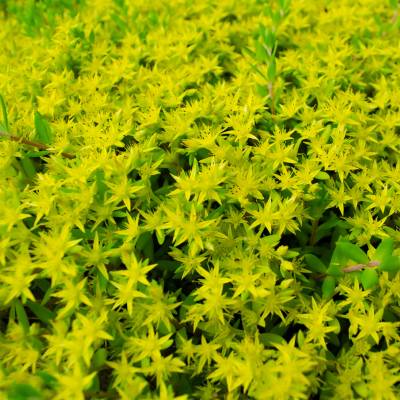
Moss Stonecrop
The moss stonecrop has thick green leaves in the summer. It is a bright and expansive plant that can carpet an entire walkway. Because it’s so hardy this particular variety can withstand foot traffic and little water. Moss stonecrop can be used as an outdoor carpet or in rock gardens
The Purple Emperor
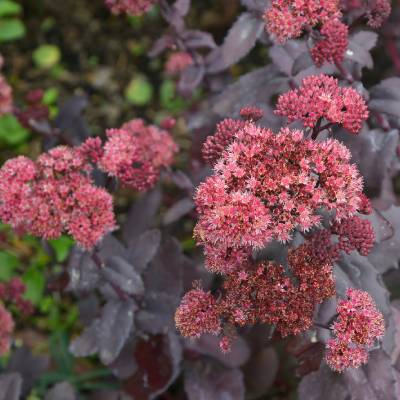
The Purple Emperor
This variety of Sedum has noticeably attractive flowers. They are typically a dark purple but can appear burgundy. The flowers are star-shaped and lewer bees and butterflies into the garden.
Sedum Cauticola

Sedum Cauticola
The Sedum Cauticola originated in Japan and has multiple, but subtle, colors. The edges of each leaf are light purple, but the leaves take on a slightly bluish hue. In August and early September, tiny pink and purple flowers can be seen inside the plant.
The Frosty Morn’
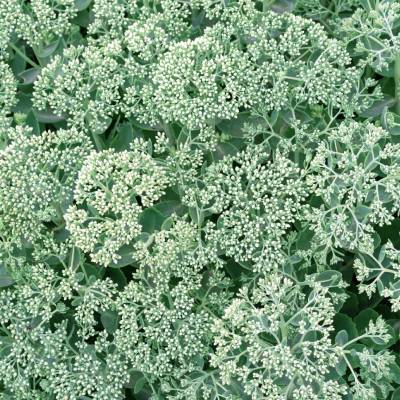
The Frosty Morn’
The Frosty Morn’ has long, vertical stems with oval leaves. Because of its particular shade of green, it often reminds people of a chilly spring morning. This Sedum plant is usually added to walls or borders. Although it’s known for its leaves, pink and white flowers do blossom in the late summer.
Broadleaf Stonecrops
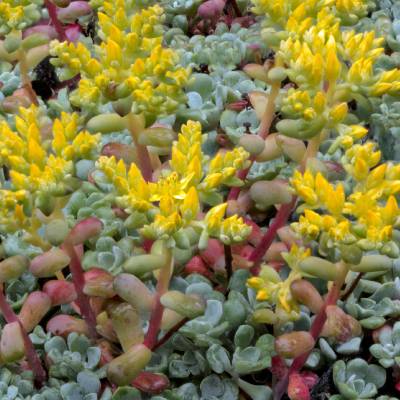
Broadleaf Stonecrops
Broadleaf stonecrops are known for their speedy growth. It’s also a helpful plant that is sometimes used to smother garden weeds. Bright yellow flowers bloom during the summer and contrast nicely with stone walkways or rock gardens.
“Vera Jameson”
Vera Jameson produces clumps of flowers. It has vibrant pink petals that can be used as background foliage or a central focal point. This Sedum will need full sun. It can reach up to 12 inches in height.
The Angelina
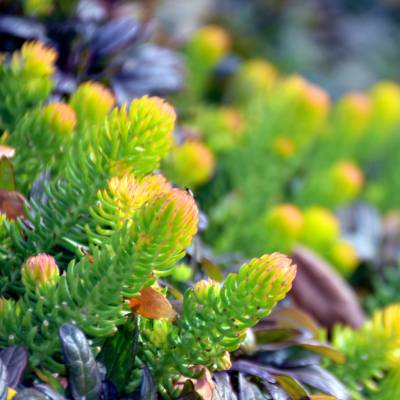
The Angelina
Sedum Angelina is a low-maintenance ground plant that cannot be ignored. It has show-stopping gold foliage that will deepen as the summer continues. By fall The Angelina turns bright orange with star-shaped flowers that can be seen from a distance. It is often draped over banisters and brick walls.
How To Create More Sedums
Sedums can grow in almost any landscape that has enough sun. Since they are so attractive and easy to maintain, many gardeners wish they had more. Dividing Sedums is a wonderful way to add texture and color to additional walls, gardens, and terrain.
To divide and transfer, first prepare the transplant site. Wherever the plant is transferred, it will need adequate sun, soil, and space. After choosing a designated spot, dig the entire plant out of the ground (roots and all). Using a sharp knife, the plant can then be divided into five-inch sections.
After replanting part of the Sedum, make sure the soil is firmly in place. The Sedum that is replanted in a new area will need to be immediately watered. In approximately one month, you’ll have twice the flowers!
Recent Articles

















